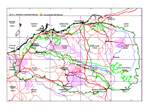Click on images
to enlarge



Photographer: B.R. Maslin

Photographer: B.R. Maslin

Photographer: B.R. Maslin
, B Archer 1784, lab photo by Fiona McCallum ADJUSTED_sml.jpg)
Seed from one herbarium voucher. Scale in mm. Photographer: F. McCallum.
Botanical name
Acacia nyssophylla F. Muell., Fragm. 4: 4 (1863)
Common name
Pin Bush, Wait-a-while and Spine Bush
Description
Dense, much-branched, prickly, spreading, multi-stemmed, obconic or rounded shrubs 1.5-2 m tall and 3-4 wide (0.5-3 m high and to 5 m wide outside the Pilbara), often wider than tall. Bark light grey and smooth to upper branches, fissured at base of oldest stems. Branchlets appressed-hairy (at least at nodes) but becoming glabrous with age, marked with prominent scars where phyllodes have fallen. Phyllodes sessile, inserted on distinct, yellow stem-projections, sub-terete to compressed, (10-) 15-25 (-35) mm long, 0.8-1.5 mm wide, very rigid, wide-spreading, straight to shallowly curved, not shiny, glabrous or almost so, pale to mid-green or yellowish green; parallel longitudinal nerves numerous, fine, close together and somewhat obscure; narrowed at apex into a slender, very sharp, rigid point. Inflorescences simple, commonly 2 per axil; peduncles 3-10.5 mm long, glabrous or sparsely appressed -hairy; heads showy, sweetly-scented, globular, rarely obloid, buttercup yellow to golden, 12-19-flowered. Flowers 5-merous; sepals free or sometimes to 1/2-united. Pods curved and twisted or coiled, linear, slightly constricted between seeds, 3-6.5 cm long, 2-5 mm wide, firmly chartaceous, hairs sparse or absent. Seeds longitudinal in pods, obloid to ellipsoid, (3.5-) 4-5 mm long, 2-2.5 mm wide, glossy, dark brown to black; the aril yellow or orange, large and partially enclosing the seed.
Characteristic features
Much-branched, prickly shrubs. Branchlets marked with raised scars where phyllodes have fallen. Phyllodes sessile, inserted on distinct stem-projections, ±terete, short (mostly 15-25 mm), very rigid, wide-spreading, finely multi-striate; needle-sharp points. Inflorescences simple, heads golden. Pods curved and twisted or coiled, 2-5 mm wide. Seed arils large and yellow or orange.
Distribution and ecology
Widespread in arid and semi-arid regions from near Geraldton, Western Australia, through Northern Territory and South Australia to far northwest Victoria and southwest New South Wales. In the Pilbara A. nyssophylla is known from two populations on Balfour Downs Station which represent the northernmost occurrence of the species in Western Australia (the nearest known populations occur in the Little Sandy Desert, about 200 km south of Balfour Downs). The Balfour Downs population occurred low in the landscape in gently undulating terrain in very friable calcareous soil over calcrete, in mallee eucalypt shrubland.
Flowering and fruiting period
Flowers in July and August in the Pilbara, but flowering may extend to October in other areas. Pods have not been collected from Pilbara plants but mature seed has been collected in late November and December in other areas.
Affinities
Most closely related to A. colletioides which does not occur in the Pilbara. Acacia nyssophylla is not likely to be confused with any other Pilbara species on account of its short, ±terete, rigid, sessile, multi-nerved and sharply pointed phyllodes.
Notes
Suitable for planting in inland areas as an ornamental (showy when in flower) or for soil stabilization (spreading growth form) or live fences (prickly foliage).
Provides a safe nesting habitat for birds.
Conservation status
Although this species is rare in the Pilbara it is common in other areas and is therefore not considered rare or endangered.
Origin of name
The botanical name is derived from the Greek nysso (to pierce) and phyllon (leaf) referring to the stiff, pungent -pointed phyllodes.
